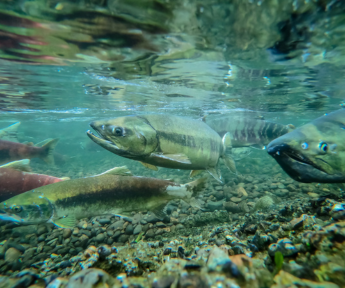Abstract
Imperilled species legislation is a critical tool at various levels of government for biodiversity conservation. In this article, we examine the opportunities and limitations of Canada's Species at Risk Act (SARA) to protect a highly threatened population of Pacific salmonid in British Columbia—the Thompson River steelhead (Oncorhynchus mykiss). To date, no Pacific salmonids have been listed under Canada's SARA despite critical population declines. The case of Thompson River steelhead is relevant because this species is often viewed as the “canary in the coal mine” for other Canadian Pacific salmonids and recently went through the Canadian listing process for imperilled native species. Thompson River steelhead, which is a culturally and socio-economically valuable migratory salmonid species, was deemed to be “endangered” by the Committee on the Status of Wildlife in Canada (COSEWIC) following an emergency assessment completed in February of 2018. The assessment noted population declines of 79% over the last three generations, yet Thompson River steelhead were ultimately not listed under Canada's SARA. Our analysis of this case is based on semi-structured interviews with individuals involved with, or knowledgeable about, the COSEWIC and SARA listing process for Thompson River steelhead (N = 17). Findings from these interviews point to several structural and institutional reasons why this species was not listed despite its precarious status: (1) spillover effects from listing species under SARA, (2) time required to complete listing processes, (3) reactive rather than proactive emergency listing processes, (4) listing decisions based on socioeconomic considerations rather than conservation science, and (5) lack of transparency in listing processes. Interview participants suggested several solutions to overcome these limitations, including (1) allowing for the management of co-migratory stocks following SARA listings, (2) expediting listing timelines, (3) making listing processes more pro-active, and (4) ensuring transparent, science-based decision-making. Our analysis demonstrates the potential of SARA listings to protect aquatic species and suggests paths forward to improving the effectiveness of Canada's SARA.
Introduction
As climate change and other anthropogenic factors threaten biodiversity at an alarming scale (Sala et al. 2000; IPCC 2021), governments around the world have taken action to implement legislation and strategies to protect native species (Lindgren 2001; Rodrigues et al. 2006; Xu et al. 2021; Hermoso et al. 2022). One common method of managing imperilled species is through government-determined imperilled species inventories, which list species according to their conservation status and extinction or extirpation risk. Such listings happen at the international, national, and provincial/state levels. For example, the IUCN Red List of Endangered Species lists species at the international level to provide comprehensive information on the global status of species (but it is non-legislative), Canada's Species at Risk Act (SARA; SARA 2002) and the US Endangered Species Act (US ESA; U.S. Congress U.S. 1973) list species at the national level, and some provincial governments in Canada have provincial-level legislation (e.g., the Endangered Species Act of Ontario (Government of Ontario 2007); the Wildlife Act of British Columbia (https://www2.gov.bc.ca/gov/content/environment/plants-animals-ecosystems/species-ecosystems-at-risk/legislation).
These lists are valuable conservation tools as they can provide imperilled species with visibility, legal protections, and mandated recovery plans (Rodrigues et al. 2006). Furthermore, government involvement has been shown to be the greatest predictor of increased conservation efforts and investments (Baynham-Herd et al. 2018). However, listing imperilled species as a conservation strategy has its shortcomings (see Bachman et al. 2019). Resources for listing are finite, decisions to list are often reactive and not conducted in a timely manner, and enforcement and monitoring following listing is often weak or non-existent (Beatley 2000; Schwartz 2008; Bachman et al. 2019; Buxton et al. 2020). Furthermore, listing processes may consider economic costs when making decisions, and give preference to species that have no economic value or do not conflict with other government priorities (Bachman et al. 2019; Mandrak 2025). For example, Shultze et al. (2013) found that listing fish under Canada's Species at Risk Act (SARA) is determined more by the costs associated with protection than by the conservation status of the candidate species.


